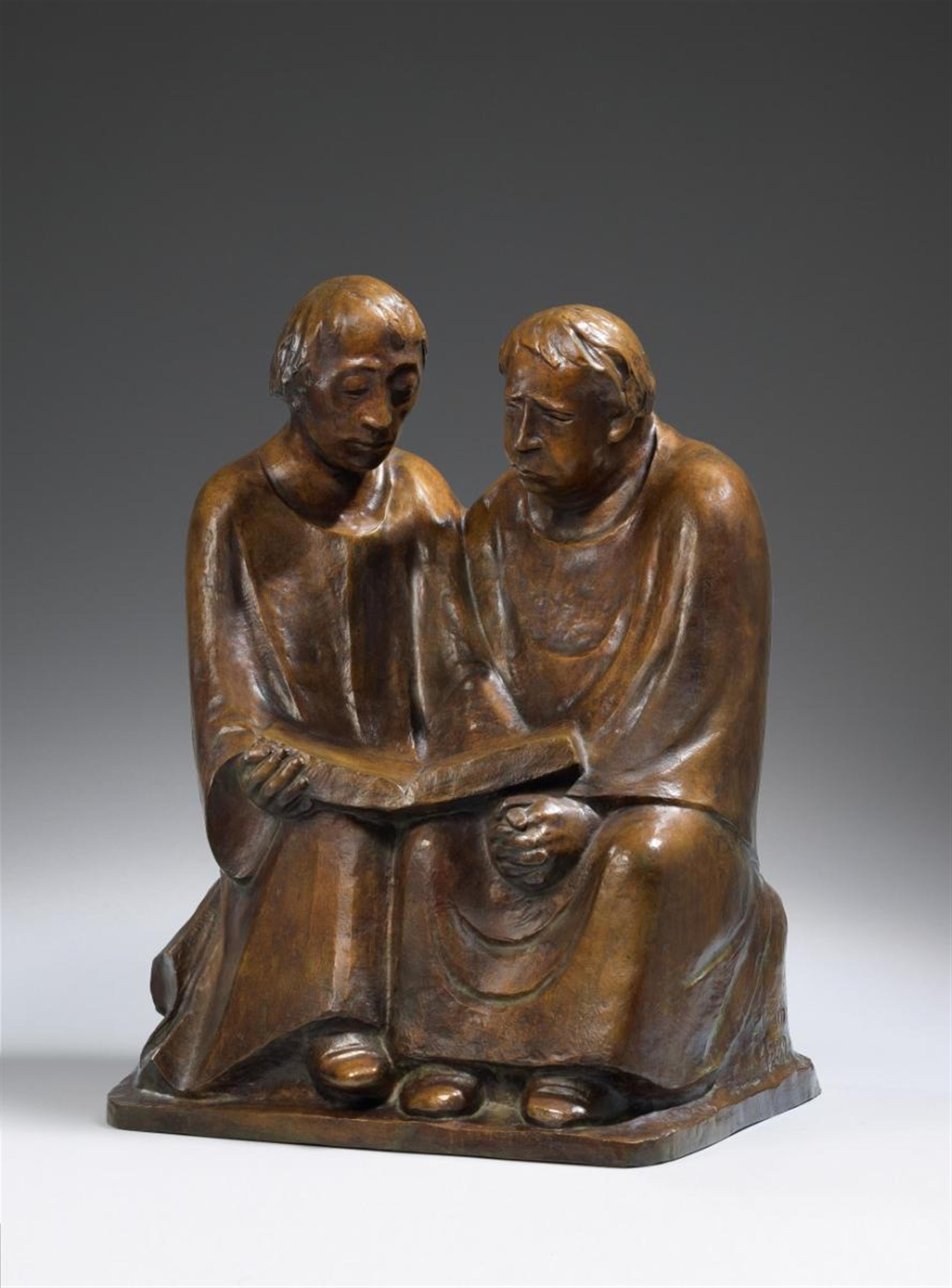Ernst Barlach
Die lesenden Mönche III
1932
Bronze Height 58 cm Signed and dated 'E.Barlach 1932' lower left side. Foundry stamp "H. NOACK BERLIN" reverse lower right. One of 25 unnummbered casts. - With a fine, golden-brown patina. - In very good condition.
Before casting the bronze version of his “Lesenden Mönche III” and a unique oakwood piece (Laur 531) of the same, Barlach first created a working model in plaster (Laur 527, with several casts). In addition, there is a “Männliche Maske”, made from unfired clay, with which the artist prepared the face of the monk on the right and which was later also cast in bronze (Laur 529 and 530).
Ernst Barlach had begun to study the subject of reading monks quite early, in 1921, when he created two small versions on the same theme. “Die lesenden Mönche I” (Laur 317 and 318) is still rather block-like and not very elaborate in its execution, and “Die lesenden Mönche II” (Laur 319 and 320), is angular and nervous in structure. A copy of the latter is also on offer in this auction.
In 1932, when the artist returned to the subject of two monks sitting closely together and immersed in a book, he used a vocabulary of form that was characterised by softly rounded contours and more attention to detail. Their faces, their hairstyles and their postures have been rendered more precisely, showing them in their individuality, as two men of different ages.
Influenced by formal aspects of mediaeval sculpture, Barlach also included the elaboration of the two men's clothing as a way to express their emotional state. In this sculpture the smooth material of the garments is shown with a small number of soft creases that enfold - and at the same time hint at - the shapes of the men's bodies. The garments thus accentuate the impression of scholarly contemplation and a deep inner peace which emanates from the two monks as they pursue their studies. Elisabeth Laur emphasises this point as a clear difference from the first two versions: “The surface has been carefully smoothened, and the garments fall down in wide, sweeping movements, bringing the two figures even closer together. These are the two elements that mainly give the sculpture its appropriate serenity and intensity.” (in: Ernst Barlach - Das plastische Werk, Werkverzeichnis II, Güstrow 2006, p. 44).
Catalogue Raisonné
Laur 528; Schult 420
Provenance
Galerie Wilhelm Großhennig, Düsseldorf 1959; Private collection, Westphalia
Literature
Friedrich Droß (ed.), Ernst Barlach, Die Briefe II (1925-1938), Munich 1969, no. 996 & p. 835; Georg-W. Költzsch (ed.), Skulptur, Plastik und Zeichnungen von Bildhauern des 19. und 20. Jahrhunderts aus der Sammlung der Modernen des Saarlandmuseums Saarbrücken, ed. by Helga Schmoll gen. Eisenwerth, Saarbrücken 1989, p. 56 f.; Stiftung und Sammlung Rolf Horn, ed. by Heinz Spielmann, 2. edition, Schleswig 1995, no. 124; Catalogue of Collections, Shizuoka Prefectural Museum of Art, Shizuoka 1996, p. 168; Hirshhorn, Museum and Sculpture Garden, Washington 1996, p. 8; Ernst-Gerhard Güse, Meisterwerke des 20. Jahrhunderts, Saarlandmuseum Saarbrücken, Saarbrücken 1999, p. 226
Exhibitions
Düsseldorf 1959/60 (Galerie Großhennig), Ausstellung auserlesener Kunst des 20. Jahrhunderts. Gemälde, Plastik, Aquarelle, with illus. without p.; Hamburg 2003 (Hauptkirche St. Katharinen), Ernst Barlach, Mystiker der Moderne, p. 313; Kyoto/Tokyo/Kofu 2006 (The National Museum of Modern Art/The University Art Museum/Yamanashi Prefectural Museum of Art), Ernst Barlach Retrospektive, cat. no. 148

